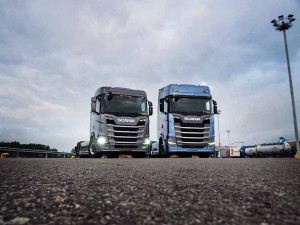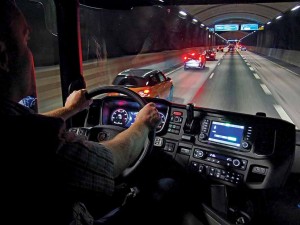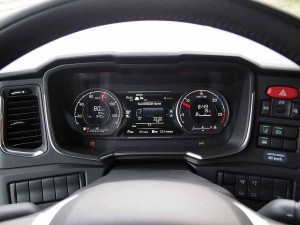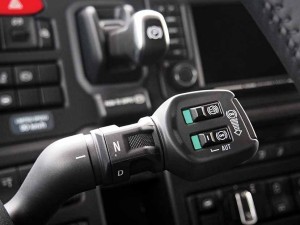Scania’s new truck range is part of a 10 year outlook to increase its market reach.
Story by: Team CV
Scania’s new generation truck range has come out in the open. The new range was unveiled in Paris and streamed live across the globe. Claimed to be an outcome of 10 years of development, the new range saw the company invest SEK 20 billion. Developed with an objective to redefine a premium truck offering, the new generation truck is expected to appeal to a wide range of audience, including those that are looking at customised products. Henrik Henriksson, President and CEO of Scania, at the event, mentioned that the development of the new truck marked the biggest investment in the history of the company. “It is undoubtedly the biggest investment in Scania’s 125 year history,” announced Henriksson. “The new products and services will bring Scania to new levels of market shares over the next decade,” he added. Mentioned Christian Levin, Head of Sales and Marketing, “To truly deliver on our mission we needed a step change in three critical areas – driver eperience, customer profitability and sustainability. We could only do that by introducing a brand new truck. What we are launching is not just a new truck range, but billions of complete and unique transport solutions. We want our customers to be profitable and sustainable than ever before.” The underlying theme of the launch was a modular system, added performance stages, connectivity and a comprehensive palette of productivity-enhancing services coupled with sustainable transportation solutions. The new truck range thus features a completely overhauled cab, and is actually a part of the S and R model range.
Embodying the Scania image in a true sense according to Levin, the new truck range promises outstanding performance and innovative services. The modular construction of the truck assures ease of maintenance. The cab, which contributes towards the stunning looks of the new truck, according to Levin, goes beyond everything that Scania has done until now. Retaining the connection with the earlier Scania trucks in terms of appearance with its horizontal ribs in the grille, the cab sets the new truck apart. Despite looking typically Scania, this is an all-new truck according to Levin. “At the top of the range,” he explained, “is the S series with a complete flat floor and maximum interior space.” The cab, designed in close cooperation with sister company Porsche Engineering, not only offers maximum interior space, it is also safe and aerodynamic. “Driver environment, fuel economy, optimum use of interior space are some of the key areas that have been focused upon, and have influenced the cab as well as the overall design,” remarked Henriksson. With more variants to follow as part of Scania’s modular system, the company claims to have no less than 24 basic cab models on offer. “Stress is on providing a customised offering for the customers,” explained Henriksson.
Driver experience
Boasting of having a height that should make it comfortable for drivers measuring between 150 and 200 cm of height, the new generation truck, in terms of driver experience, will offer the most ergonomic and driver spacious cab like the earlier Scanias have offered. “Scania engineers found out, that by moving the driver position 65 mm forward, and a tiny 20 mm out, a considerable improvement could be achieved. Both, in terms of visibility as well as ergonomics,” mentioned Levin. Built using high-tensile steel with the structural elements shaped using advanced technology to create a monocoque structure, the task of building the cab proved to be a challenge. According to Göran Hammarberg, Head of Cab Development at Scania, it proved to be a complex process that involved the incorporation of factors like visibility, comfort, legal requirements, ergonomics, good repair-ability, low weight and high safety. Emphasis was laid on building a cab around the trucker so that he has the best working and living environment. From the shape of the steering wheel to the personalised instrument cluster, every element was given considerable attention to turn out a thoroughly driver-centric set up. “The interior quality of this trucks is something that the industry has not seen before,” Levin expressed.
Stress, in design terms, was laid on an athletic build. The truck would have to look muscular. It had to look agile and well proportioned. Mentioned Kristopher Hansen, Head designer, “An important consideration in cab design was fuel economy. Every surface, at the front as well as the sides, and even below the vehicle has been optimised for minimum drag. Even components like wipers, rear-view mirrors and the various lights have been designed with this in mind.” To reduce fuel consumption by two per cent, attention was paid to improve the cab’s ability to cheat the wind. Featuring a large glass surface for improved visibility, the instrument panel is set lower. Door panels are slimmer, and A-pillars have been optimised. Rear-view mirrors have been given due attention too. The mirrors in both the R and S cabs have been given a wide-angle function. Electrically adjustable, the mirrors can also be heated, and are engineered to effectively dampen vibration. Stress was laid on sound, colour and functionality in particular. These would not just enhance the driver experience, but also bring about that feeling of being in command of the magical power underneath, said Hansen.

Safety
To improve steer-ability, the erstwhile steered tag axles have turned electro-hydraulic. The steering angle was increased from 14 to 19 degrees to imprive the steering feel. A 30 kg weight reduction are among the various benefits the new truck would offer. First to offer a rollover side curtain airbag (integrated into the cab roof) according to Levin, the new truck has seen an improvement in braking performance. According to Levin, the new truck sets a benchmark in braking performance. This was achieved by moving the front axle forward while introducing a new suspension and braking system. Moving the axle forward has reduced the kneeling effect under heavy braking. New software has also been developed, averred Levin. “The new truck stops 2 m earlier,” he added.
The heart of the system
Presenting Scania with the opportunity to further expand the already broad spectrum of engines on offer, the new truck has been instrumental in taking the range of engines to 55; between seven and 16-litres of volume. During the launch phase of the new truck, the SCR and V8 engines will see further improvement. The Euro-six engines will get new engine management systems, and their installation has been overhauled. Featuring improved cooling capacity, the new truck is powered by an in-line 13-litre, 500 hp engine mated to an automated opticruise gearbox. Found on the new generation truck range wil be the Opticruise transmissions. Mentioned Björn Westman, Scania’s Head of Engine Development, that the engines require only Selective Catalytic Reduction (SCR) for after treatment of exhaust gases in order to meet Euro-six standards. “Our inline 13-litre engine performs fantastically well with only SCR and a robust fixed geometry turbocharger,” he added. He further explained, “With this addition we are, from a power perspective, offering a concept that will appeal to a large number of customers in a wide range of applications.” Quipped Levin, that with the new range, Scania has succeeded in further reducing the fuel consumption. “A reduction of at least five per cent has been achieved,” he expressed. Levin also emphasised upon this being a true step change, and was achieved through a combination of factors including aerodynamics.
With the new generation truck range, Scania will also introduce super low ratio rear axle gear ratio of 2.35. This will contribute towards reducing fuel consumption by allowing the driver to drive the truck faster and at lower engine revs. Averred Levin that Scania will be offering a variety of alternate fuel propulsion technologies including bio-diesel, bio-ethanol, bio-gas in the form of LNG and CNG, and hybrid. Supported by a long standing experience in the manufacture of commercial vehicles, the new truck range was tested over 10 million kms. Designed to stay longer out there on the road and contribute more to the earning of its operator, the truck accounts for 10 years of development work.
Introducing a lay shaft brake system as standard in the opticruise gearbox, Scania will be globally introducing the new truck range in five phases. Improving the driving experience, the new Scania truck has been test driven for 10 million kilometers. All set to redefine the term ‘premium’, the new generation Scania is set to make it to India too.























